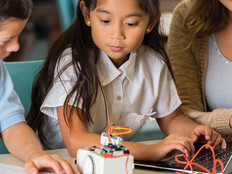ISTE 2012: How Are Schools Adapting to the Learn Now, Lecture Later Movement?
The idea of a teacher serving as a “sage on the stage” has given way to an alternate approach, one in which the teacher now functions as a “guide on the side” so that students can steward their own learning experience through collaborative activities made possible (or enhanced) by technology. In schools around the country, teachers are beginning to make their lectures available to students to view outside of class and dedicating classroom time to hands-on learning and group projects.
To understand how flipped classrooms, blended (or hybrid) programs, and distance, virtual and online learning are transforming classrooms, CDW•G surveyed 1,015 high school and higher education students, faculty and IT staff in May and June 2012. The resulting Learn Now, Lecture Later report, released during a Monday morning session at the ISTE 2012 conference, looks at how technology can support the move to new teaching and learning models and what challenges schools must overcome to transition successfully.
Julie Smith, CDW•G’s vice president for K–12 education, shared a few highlights from the report and spearheaded a discussion about its key findings with a panel of educators that included:
- Dr. Manuel L. Isquierdo, superintendent, Sunnyside Unified School District, Tucson, Ariz.;
- Mike Buckhave, assistant superintendent of personnel and instruction, Oro Grande (Calif.) School District;
- Michael Andreasen, director of information technology, Oro Grande School District; and
- Mark Washington, director of information technology and media services, Port Huron Area School District, Port Huron, Mich.
The What and Why of Learn Now, Lecture Later
According to the report, 53 percent of surveyed high school students say they’re taught using the traditional lecture model, but only 38 percent say that’s how they want to learn. Instead, students would prefer more hands-on projects (17 percent), group projects (12 percent), independent study (14 percent), distance or virtual learning (11 percent) and one-on-one tutoring (8 percent).
“When students take ownership of their learning, it means so much more to them,” Andreasen acknowledged.
Just over two-thirds (69 percent) of surveyed students also indicate that they would like to incorporate even more technology into their classes as a learning tool. Their top five preferred devices include notebook computers and netbooks, tablets, smartphones, digital content and recorded class lectures.
Teachers, meanwhile, say having notebooks and netbooks, tablets, digital content, learning management systems, telepresence, recorded class lectures, e-readers and smartphones would help them move away from traditional lectures. Isquierdo seconded this idea, telling attendees that “every teacher should have an iPad and a laptop so they can learn right along with their students.”
Three-quarters of the IT professionals who participated in the survey say that faculty requests for help with technology integration and related professional development have been on the rise over the past two years. Popular requests include training on specific classroom technologies (57 percent), training on instructional software (42 percent) and guidance on integrating technology into the curriculum (38%).
“Every principal and superintendent needs to model what we’re asking teachers to do,” Isquierdo said. “We can’t afford to let teachers fail. We can afford to let them experiment.”
The Port Huron Area School District, for example, employs a full-time trainer who visits each school in the district two to three times each month and is available to teachers for one-on-one or group consultations. “It was important to us that professional development go along with everything we do,” Washington said. “So we embedded training into the school day.”
Also notable is that 87 percent of the IT pros surveyed say they need to upgrade their district or institution’s infrastructure in order to incorporate more technology in the classroom. Top additions or upgrades cited include server and storage improvements (51 percent), wireless and networking infrastructure (49 percent), cloud computing (42 percent), security (37 percent) and virtualization (33 percent). “You need to make sure you have the infrastructure built to support what you want to do in the classrooms,” Andreasen said.
In the end, the panelists agreed that technology must be deployed strategically and transparently. “It’s just as important as a lunch program,” Isquierdo said. “It is the game-changer.” Added Buckhave: “It’s crucial that we design programs and instruction that helps facilitate that. Technology isn’t everything. Drill-and-kill instruction just won’t work anymore.”
For more articles and videos on ISTE 2012, check out all of our ISTE content on the ISTE 2012 conference page.
Recommended Roadmap
The CDW•G Learn Now, Lecture Later report suggests school leaders take the following steps to successfully transition to new classroom learning models:
- Get to the heart of what students and faculty want: Understand the technology your users already have, how they want to use it in class, and how they best learn and teach.
- Consider how to incorporate different learning models: Work closely with faculty to meet their course, curriculum and personal teaching styles.
- Explore how technology can support and enhance learn now, lecture later: Enable the community to consult with each other and share best practices.
- Support faculty with professional development and IT with infrastructure: Unless faculty are comfortable, the change will be slow and without IT, the change may not happen at all.
For more from the Learn Now, Lecture Later report, visit CDWG.com/LearnNowLectureLater.







